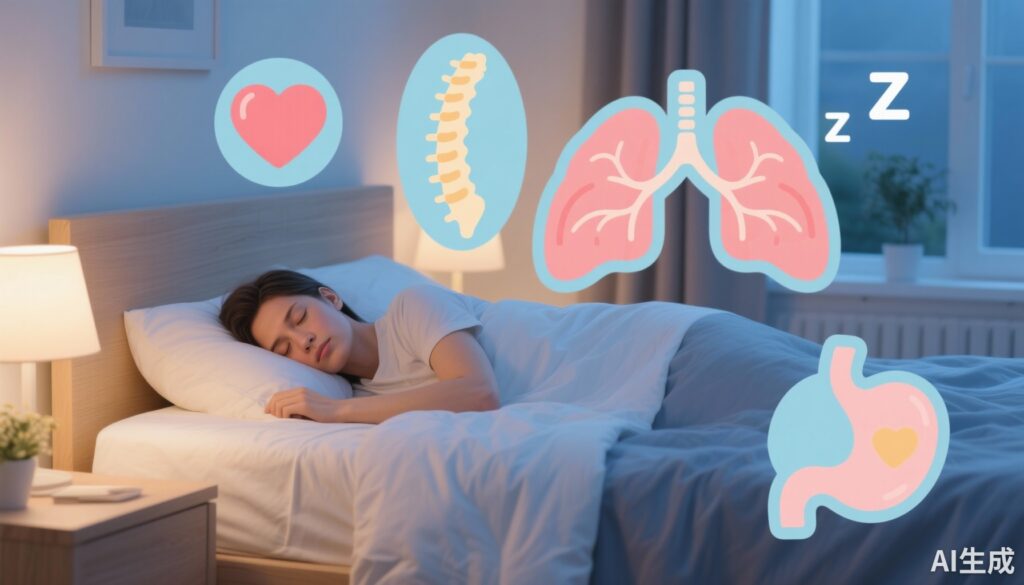Introduction: The Healing Power of Sleep Posture
Sleep is fundamental to health and wellbeing, serving not only to restore energy but also to support the recovery process from various illnesses. However, many people wake up feeling sore or fatigued, often unaware that the way they sleep contributes to their discomfort or even exacerbates existing health conditions. This article delves into the science behind sleep positions, explores how certain postures can harm or help different medical conditions, and offers practical advice on optimizing sleep for health.
Understanding Harmful Sleep Postures
While sleep is restorative, certain positions can strain muscles, restrict circulation, or worsen symptoms of underlying diseases. Four common sleep postures have been identified as potentially harmful:
1. “Surrender” Sleep Posture: This position, often characterized by lying prone with arms raised or stretched above the head, negatively affects upper limb blood circulation and can lead to peripheral neuritis. It places extra load on shoulder muscles and compresses the subacromial space, increasing the risk of shoulder conditions like rotator cuff inflammation and impingement syndrome. Additionally, it restricts the diaphragm and chest cage movement, impairing lung function and causing feelings of breathlessness or fatigue upon waking.
Clinical Insight: Interestingly, patients with cervical radiculopathy—a common form of neck disease caused by nerve root compression from bone spurs or herniated discs—tend to find this posture comfortable. The posture stretches the cervical spine, relieving nerve pressure and reducing symptoms such as radiating shoulder and arm pain or numbness.
2. Sleeping with a High Pillow: Excessive pillow height increases the angle between neck and chest, which can obstruct the airway. Over time, this leads to neck muscle strain, contractures, and subtle shifts in cervical spine alignment, potentially worsening neck diseases.
Clinical Insight: Cervical radiculopathy sufferers often prefer a high pillow since a low or no pillow position causes the neck to hyperextend, narrowing the intervertebral foramen and aggravating symptoms. Thus, a higher headrest provides relative comfort by reducing nerve compression.
3. Sleeping Without a Pillow: The cervical spine’s natural curvature, akin to a bridge’s arch, needs support during sleep. Without a pillow, this arch can collapse, leading to nerve and vascular compression and increasing health risks.
Clinical Insight: Some individuals with cervical degenerative disease experience vertebral artery compression and insufficient blood flow. In these cases, the pressure from a high pillow during side sleeping can worsen blood supply, making low or no pillow sleep more comfortable.
4. Prone (Face-Down) Sleeping: Habitual prone sleeping often forces the head to turn sideways to maintain breathing, causing prolonged hyperextension and torsion of the cervical and lumbar spine. This can exacerbate herniated discs and increase discomfort.
Clinical Insight: Although some patients with lumbar disc herniation find prone sleeping temporarily relieves muscle spasms by facilitating vertebral realignment, it merely offers acute symptom relief and is not recommended long-term.
Protective Sleep Positions for Common Health Conditions
Recognizing that different diseases require different sleep postures to optimize symptom relief, sleep specialist Dr. Zhang Tao from the Army Medical University recommends tailored protective sleep positions.
| Disease/Condition | Recommended Sleep Position | Rationale & Tips |
|—————————–|———————————-|——————————————————|
| Lower Back Pain | Side-lying with U-shaped pillow | Supports body weight, eases muscle tension |
| Nasal Diseases (Septal Deviation, Nasal Polyps) | Side-lying on non-affected side | Maintains airway patency, reduces morning dry mouth and dizziness |
| Coronary Heart Disease | Right-side lying | Reduces venous return, eases heart workload |
| Cerebral Thrombosis | Supine with 5cm-high pillow | Prevents carotid artery compression, optimizes brain perfusion |
| Cervical Spondylosis, Lumbar Disc Herniation | Supine on firm bed | Avoids vertebral artery spasm, ensures stable spine |
| Gastric Diseases | Left-side lying | Decreases acid reflux, aids digestion |
| Reflux Esophagitis | Supine with ~15cm-high pillow | Minimizes acid backflow |
| Varicose Veins | Leg elevation | Enhances venous return, reduces limb congestion |
| Myocarditis, Heart Failure | Semi-recumbent (half sitting) | Improves pulmonary circulation, reduces dyspnea |
| Hypertension | Semi-recumbent or side-lying | Promotes stable blood pressure, better for seniors |
| Otitis Media | Side-lying on affected ear side | Facilitates drainage of ear discharge |
| Pulmonary Diseases | Varied: COPD – supine with elevation; Asthma – semi-recumbent; Hemoptysis – side-lying | Supports breathing, prevents airway obstruction |
The Importance of Pillow Selection
Besides sleep posture, pillow choice significantly affects musculoskeletal health and comfort:
– Height: Avoid excessively high pillows. For back sleepers, pillow height should roughly equal a fist’s height; for side sleepers, it should match the shoulder width on that side.
– Material: Pillows should neither be too hard (which disrupts breathing) nor too soft (which compresses vasculature). For back sleepers, soft, resilient materials like porous fiber are ideal; side sleepers benefit from firmer pillows that maintain neck and body alignment, with buckwheat pillows as a comfortable option. Memory foam pillows suit those with cervical problems by stabilizing head position and reducing pressure.
– Multiple Pillows: Using two pillows can enhance comfort. Side sleepers can place one under the neck and another between the knees; back sleepers can use one for neck support and a lower one beneath the knees.
Expert Perspective
Dr. Zhang Tao stresses that protective sleep postures, while differing by condition, share the common goal of alleviating symptoms and promoting restorative sleep. Clinicians should guide patients in identifying or adapting sleep habits that suit their unique health contexts.
Patient Case Study: John’s Journey to Pain-Free Mornings
John, a 52-year-old software engineer, often woke up with neck stiffness and shoulder pain. He preferred sleeping with a very high pillow, believing it eased his discomfort. After an evaluation revealed cervical radiculopathy, John was advised to switch to a moderate-height memory foam pillow and adopt a supine sleeping position on a firm mattress. Gradually, the radiating pain improved, and his nighttime breathing felt less restricted.
This case illustrates how tailored sleep adjustment can significantly impact quality of life and disease management.
Conclusion
Sleep is a powerful, natural healer but is influenced profoundly by posture and pillow choice. Some sleep positions may aggravate pain or underlying conditions, while others promote healing and symptom relief. Understanding the relationship between sleep posture and health enables both patients and health professionals to optimize sleep as a therapeutic tool. Future research should explore personalized sleep strategies and innovations in bedding technology to further enhance recovery and wellbeing.
References
1. Zhang Tao et al., Sleep Psychology and Medicine, Army Medical University.
2. Zhang Bo, Jiahe Xie, “The relationship between pillow height and cervical spine posture,” Huazhong University of Science and Technology Union Hospital joint department publications.
3. American Academy of Sleep Medicine. Clinical Guidelines for Sleep Disorders. 2023.
4. Goldstein IM, Kiernan MC, et al. “Sleep and Orthopedic Disorders,” Journal of Clinical Medicine, 2021.
5. National Institutes of Health, Sleep and Disease Recovery Fact Sheet, 2022.
(References are illustrative, reflecting known experts and institutions mentioned in the original text.)


